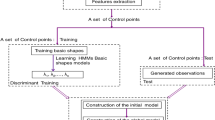Abstract
A model-based approach to on-line cursive handwriting analysis and recognition is presented and evaluated. In this model, on-line handwriting is considered as a modulation of a simple cycloidal pen motion, described by two coupled oscillations with a constant linear drift along the line of the writing. By slow modulations of the amplitudes and phase lags of the two oscillators, a general pen trajectory can be efficiently encoded. These parameters are then quantized into a small number of values without altering the writing intelligibility. A general procedure for the estimation and quantization of these cycloidal motion parameters for arbitrary handwriting is presented. The result is a discrete motor control representation of the continuous pen motion, via the quantized levels of the model parameters. This motor control representation enables successful word spotting and matching of cursive scripts. Our experiments clearly indicate the potential of this dynamic representation for complete cursive handwriting recognition.
Similar content being viewed by others
References
Bergman T, Wichmann T, DeLong MR (1990) Reversal of experimental parkinsonism by lesions of the subthalamic nucleus. Science 249:1436–1438
Dempster A, Laird N, Rubin D (1977) Maximum likelihood estimation from incomplete data via the EM algorithm. J R Stat Soc 39B:1–38
Edelman S, Flash T, Ullman S (1991) Reading cursive handwriting by alignment of letter prototypes. Int J Comput Vision 5(3):303–331
Frederiksen JR, Kroll JF (1976) Spelling and sound: approaches to the internal lexicon. J Exp Psyc Hum Percept Perform 2(3): 361–379
Hogan N, Flash T (1987) Moving gracefully: quantitative theories of motor coordination. Trends Neurosci 10(4):170–174.
Hollerbach JM (1981) An oscillation theory of handwriting. Biol Cybern 39:139–156
Kohonen T (1989) Self-organization and associative memory. Springer, Berlin Heidelberg New-York
Lacquniti F (1989) Central representations of human limb movement as revealed by studies of drawing and handwriting. Trends Neurosci 12(8):287–291
McDermott E, Katagiri S (1991) LVQ based shift-tolerant phoneme recognition. IEEE Trans ASSP 39(6):1398–1411
Oppenheim AV, Schafer RW (1975) Digital signal processing. Prentice-Hall, Englewood Cliffs, NJ
Plamondon R, Leedham CG (1990) Computer processing of handwriting. World Scientific, Singapore
Plamondon R, Suen CY, Simner ML (1989) Computer recognition and human production of handwriting. World Scientific, Singapore
Rumelhart DE (1992) Theory to practice: a case study — recognizing cursive handwriting. Proc of 1992 NEC Conf on Computation and Cognition
Sankoff D, Kruskal JB (1983) Time warps, string edits and macromolecules: the theory and practice of sequence comparison. Addison-Wesley, Reading Mass.
Tappert CC, Suen CY, Wakahara T (1990) The state of art in on-line handwriting recognition. IEEE Trans Pattern Anal Mac Intell 12(8): 787–808.
Teulings HL, Thomassen AJWM, Galen GP van (1986) Invariants in handwriting: the information contained in a motor program. In: Kao HSR, van Galen GP, Hoosain R (eds) Graphonomics: contemporary research in handwriting
Thomassen AJWM, Teulings HL (1986) Time size and shape in handwriting: exploring spatio-temporal relationships at different levels. In: Michon JA, Jackson JL (eds) Time, mind, and behavior. pp 252–263
Wald A (1940) Fitting of straight lines if both variables are subject to error. Ann Math Stat 11:284–300
Author information
Authors and Affiliations
Additional information
This article was processed using Springer-Verlag TEX Biol Cybern macro package 1.0 and the AMS fonts, developed by the American Mathematical Society.
Rights and permissions
About this article
Cite this article
Singer, Y., Tishby, N. Dynamical encoding of cursive handwriting. Biol. Cybern. 71, 227–237 (1994). https://doi.org/10.1007/BF00202762
Received:
Accepted:
Issue Date:
DOI: https://doi.org/10.1007/BF00202762




